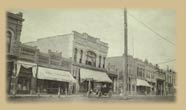| Notes |
- Judge (Magistrate
before 25 Mar 1740 - County judge for Morris Co, New Jersey
17 may 1737 moved to Roxbury, Morris Co, New Jersey
1747 Justice of the peace of Roxbury Twp
Religion Quaker (Society of Friends)
bef 1759 nearly 1000 acres in Chester twp and in Warren Co, New Jersey
Will: 10 May 1759, Roxbury, Morris Co, New Jersey
probated 13 Jun 1759
From 'Genealogy of the Swasey Family which includes the Descendants of the Swezey Families ...,' pp. 51 - 57
JUDGE SAMUEL SWAYZE4, husbandman (Joseph3, John2, John1). B. in Southold, Long Island, N. Y., March 20, 1689; d. in Roxbury Township, Morris County, N. J., May 11, 1759 ; M. in S[outhold]., (1) Penelope [handwritten: Horton]; b. at S[outhold]., Feb. 14, 1690; d. in Chester, N. J., 1746; M. (2) April 20, 1747, Susannah Huntington; b. 1696; d. 1776.
He moved with his family from Southold to the German Valley in N. J., in 1737, and settled in Roxbury, now Chester, N.J., which became known as the "Swayze Settlement," where the spelling of the name as above was then universally adopted.
He was one of the first Justices of the Peace of Roxbury Township, holding the office as early as 1747. He was one of the first County Judges as per the Court record, viz.:
"On the 25th of March, 1740 (one year after the act was passed constituting the County), the Court met at Morristown, called New Haven. The names of the judges present were Messrs. John Budd, Jacob Ford, Abraham Kitchell, John Lindley, Jr., Timothy Tuttle and Samuel Swayze."
It is quite probable that Judge Samuel Swayze was more pronounced in his views of the Quaker doctrine than the rest of his father's family, and this may have been the incentive that decided him to migrate with his family from Southold to the Colony of New Jersey. His ancestors of the Quaker faith were driven out of Salem, Mass., and hoping to find a refuge on the eastern end of Long Island, in New York, they went thither. But here they found themselves in an English colony and were ostracised and persecuted both by the Puritans and the Church of England adherents:
What is now the State of New Jersey was granted by King Charles II. in 1664 to his brother, the Duke of York, and he in turn granted it to Lord John Berkeley and Sir George Cartaret. They divided the territory into East and West Jersey. Lord Berkeley sold West Jersey to a syndicate of Quakers who colonized it and established their first settlement at Salem, N. J., in 1675, and another shortly after at Burlington, N. J. Soon after Sir George Cartaret's death a society of Quakers under the lead of William Penn?encouraged by their success in West Jersey?purchased from his heirs East Jersey. Prior to the settlement of Judge Swayze there, the population consisted of Quakers, Presbyterians and Anabaptists. There were only two Church of England ministers in the Province and their followers were too few and too poor to provide churches.
Liberty of conscience was permitted to all except Roman Catholics. Quakers were eligible to office. Loyalty to the Sovereign King of England prevailed here as in all the Provinces. But during the years immediately preceding the Revolution, New Jersey was the third Colony in order to declare for Independence, but most of the family of Judge Swayze remained Loyalists and suffered all the privations incident thereto, as will be seen in the subsequent history of their lives.
Much of the land of the original Swayze settlement still remains in the possession of his descendants.
In 1743 he bought for his sons Barnabas and Israel, 800 acres of land in the town of Hope, New Jersey, the land to be equally divided between them. This is also known as the "Swayze Settlement," and some of their descendants now live there.
To his sons Rev. Samuel and Richard he set off a part of his own land. As the Revolution was approaching they sold their land and went to Western Florida, now Mississippi, in 1773. To his son Caleb he gave another portion of his own farm but during the stormy days of the Revolution he emigrated to Canada.
At his death he left by will, dated May 10, probated June 13, 1759, nearly 1,000 acres of land to his family.
He is buried in the graveyard of the First Congregational Church at Chester, one of the oldest in the State of New Jersey.
Upon the tombstones in Chester, N. J., are the following inscriptions:
"Here lies the body of Samuel Swayze, Esqr., who was born in Southold, Long Island, March 20, 1689; and removed from thence to Roxbury, May 17, 1737, where he continued to reside until he departed this life May 11, 1759, aged 70 years 1 month and 11 days."
"Here lies the body of Penelope, the wife of Samuel Swayze, who was born in Southold, Long Island, Feb. 14, 1690, and removed from thence to Roxbury, May 17, 1737, where she continued to reside until she departed this life Dec. 1, 1746, aged 55 years 9 months and 17 days."
The monuments at these graves are of brownstone, about 200 feet northerly from the church and about 75 feet from the road fence.
This church has on it "First Congregational Church. First house of worship was erected: first, 1747, second 1803, third 1856. First Congregational Church in New Jersey. Rev. Samuel Swayze, son of Samuel Swayze, pastor.
|








 d. 01 Dec 1746, Chester, Morris Co, New Jersey
d. 01 Dec 1746, Chester, Morris Co, New Jersey  (Age 57 years)
(Age 57 years) 